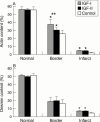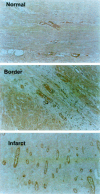Insulin-like growth factor I and II preserve myocardial structure in postinfarct swine
- PMID: 11711471
- PMCID: PMC1730040
- DOI: 10.1136/heart.86.6.693
Insulin-like growth factor I and II preserve myocardial structure in postinfarct swine
Abstract
Background: Insulin-like growth factors (IGF) I and II improve myocardial function after coronary occlusion in different animal models.
Objectives: To investigate the mechanism of improved myocardial function after administration of IGF-I or IGF-II in acute myocardial infarction.
Methods: Female pigs (mean (SD) weight 25 (5) kg) were subjected to acute myocardial infarction by microembolisation with 75-150 micrometer affigel blue beads. The beads contained and slowly released 150 microgram/pig of IGF-I (n = 6), IGF-II (n = 6), or pig albumin (n = 6). Echocardiography, perfusion imaging, and haemodynamic measurements were performed before infarction and during four weeks after infarction. Regional wall motion of different left ventricular segments was scored semiquantitatively on the basis of a three point scoring system, from normal = 0 to dyskinesia = 3. Serum cardiac troponin I concentration was measured before, immediately after, and three hours after the infarct. Excised hearts were analysed for actin, desmin, blood vessel density, and DNA laddering within the infarct, border, and normal myocardial areas.
Results: Myocardial function of the infarct related area improved significantly during the four weeks of follow up in both the IGF groups (p = 0.01). Myocardial perfusion, heart rate, and blood pressure were similar in all the animals during the study. Treated animals had lower serum cardiac troponin I concentration (p = 0.001), more actin in the border area (p = 0.01) and infarct area (p = 0.0001), and reduced DNA laddering in the infarct area compared with the controls (p < 0.05). IGF groups had more blood vessels in the border area (p = 0.04) and the infarct area (p = 0.003).
Conclusions: Both types of IGF improved myocardial function and the improvement was associated with preservation of myocardial structure. IGF-I was more effective than IGF-II.
Figures








References
MeSH terms
Substances
LinkOut - more resources
Full Text Sources
Other Literature Sources
Medical
Research Materials
